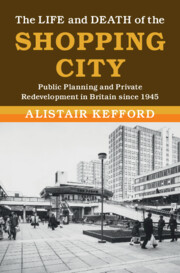 The Life and Death of the Shopping City
The Life and Death of the Shopping City Book contents
- The Life and Death of the Shopping City
- Modern British Histories
- The Life and Death of the Shopping City
- Copyright page
- Dedication
- Contents
- Figures
- Acknowledgements
- Introduction
- 1 Reconstructing Retail in the 1940s
- 2 Cities in the Age of Affluence
- 3 Making the Modern Shopping City
- 4 The Politics of Partnership
- 5 Landscapes of Leisure
- 6 Demand and Discontent in the Shopping City
- 7 Triumph of the Shopping City
- Conclusion
- List of Archives and Abbreviations
- Bibliography
- Index
3 - Making the Modern Shopping City
Published online by Cambridge University Press: 31 March 2022
- The Life and Death of the Shopping City
- Modern British Histories
- The Life and Death of the Shopping City
- Copyright page
- Dedication
- Contents
- Figures
- Acknowledgements
- Introduction
- 1 Reconstructing Retail in the 1940s
- 2 Cities in the Age of Affluence
- 3 Making the Modern Shopping City
- 4 The Politics of Partnership
- 5 Landscapes of Leisure
- 6 Demand and Discontent in the Shopping City
- 7 Triumph of the Shopping City
- Conclusion
- List of Archives and Abbreviations
- Bibliography
- Index
Summary
This chapter examines the unprecedented era of urban rebuilding which took off in the late 1950s and lasted into the 1970s, in which enthusiasm for ‘comprehensive’ town centre redevelopment and modernist urban renewal was at its peak. This was the era when shopping malls were imported from the United States and planted at the centre of British towns and cities, and these developments rested upon an unusual alignment between the modernist planning ideals of urban professionals, the developmental agendas of local authorities and the commercial strategies of a handful of development companies. I stress how important the rhetoric of modernisation was in uniting these different interests, but also how loosely and variably notions of ‘the modern’ were defined and applied. I also highlight the importance of the technocratic enthusiasms of the age, particularly in the early 1960s, when the idea of engineering efficient urban environments came to the fore. Planners, policymakers and property developers adopted a deeply Taylorist, mechanistic idea of urban renewal, in which prosperity, efficiency and growth would be precisely engineered while ‘obsolescence’ would be excised from the modern city with surgical precision. For urban authorities facing darkening economic prospects, these were seductive ideas, and viewed as a means to combat the onset of deindustrialisation.
Keywords
- Type
- Chapter
- Information
- The Life and Death of the Shopping CityPublic Planning and Private Redevelopment in Britain since 1945, pp. 113 - 162Publisher: Cambridge University PressPrint publication year: 2022
